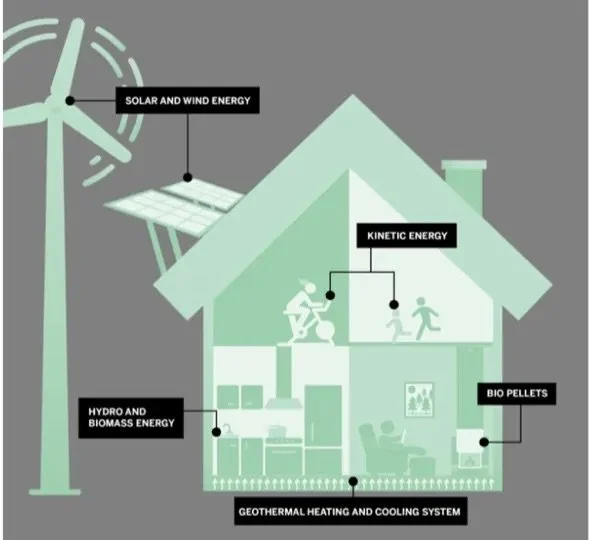Full of energy —
A picture of life in 2030
Lyla looks into her phone and sees the balance. It’s been only one month since refurbishing her home and she had already made a profit. She never thought that her home could be a source of income for her family until the architect came in with a partner from Cool Future.
The duo wanted to build a zero impact home for Lyla and her family. They assessed how much sunlight and wind the house was exposed to, the thickness of its walls and the family lifestyle. They created a project so the house could be self-sufficient in terms of energy by insulating it better, installing solar panels, mini-wind-turbines and devices that would transform the kinetic energy generated by their treadmill and spinning bike into electric energy. Even the floor would generate energy from the family’s footsteps and the water pipes would generate energy from running water — every little opportunity counts! And despite initial resistance because of pollution concerns, Susan also accepted to top-up her energy production by using bio-pellets after Cool Future showed her a device that captures the smoke that would otherwise go into the atmosphere and transforms it in charcoal that would subsequently be donated to the community art school that her son attends.
Lyla and her family love cooking meals from scratch, so there was an opportunity to produce their own compost from organic waste — she didn’t know it was that simple. Now all her banana skins, potato peels and avocado stones are turning into food for her flowers. Although Lyla’s family have never been eco-warriors, they’ve been committed to reducing their waste since they became more aware of the benefits… and that small change in lifestyle saved them quite a bit of money that they now spend on enriching experiences instead of ‘stuff’.
Illustration by Isha Suhag.
The upfront investment wasn’t that high: Cool Future rents, repairs and replaces equipments so they can regenerate them to create new ones since adopting principles of circular economy in their business. They did that in partnership with start-ups, regeneration consultancies and academia. Everybody works in collaboration these days, very different from the uber competitive business environment of the past.
The excess energy Lyla’s family produces is stored in the community hub (or micro-grid), so it can be used by her neighbours. If everyone consumes more than they generate, Cool Future ensures there is always energy available through their own renewable power plants. Cool Future can also predict weather conditions through its partnership with a Cool Telco company: Cool Future powers their network with renewable energy and Cool Telco pays back by reading weather interference in their signal and informing Cool Future of changes in sun, wind or rain patterns, so they can manage their production efficiently — no money is exchanged between the companies.
Now that Lyla is part of the Cool Future Club, she receives tips on how to improve her energy management at home and on the go. For example, she learnt she can charge her car during the evening when energy is cheaper and, if she’s not using her car, charge her house back through the car battery during the day when energy is more expensive or when it’s cloudy and energy from solar panels would be low. And if she has to charge the car whilst on the way (which is rare, as she cycles everywhere), the consumption is also linked to her house via the Cool Future App, so she doesn’t have to pay for it on the spot. All the data generated is properly protected and Cool Future uses the aggregated information from users to influence government policies that would benefit their members, society and the environment.
Over 10 years ago, despite alarming news about the climate crisis, some people and businesses were resistant to the transition to a regenerative world with lower dependency on natural resources and fossil fuels, no pollution and more community based. Now in 2030, collaboration and active citizenship are the order of the day. Renewable energy, circular business models, smart use of natural resources and co-creating projects with and for communities are just a few ways by which Cool Future makes the economy, society and the environment better and cool for everyone, everywhere.

